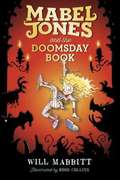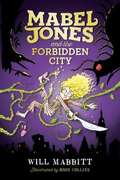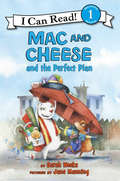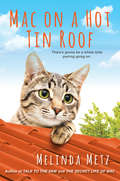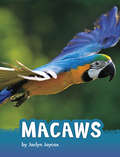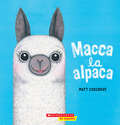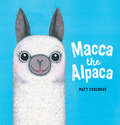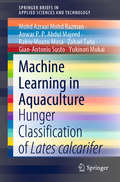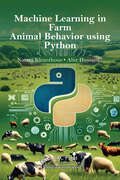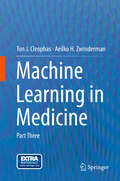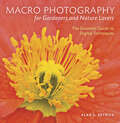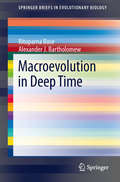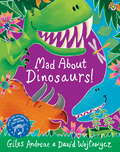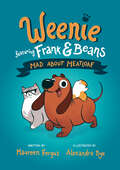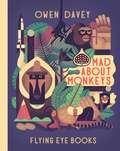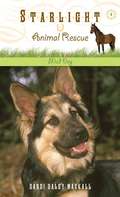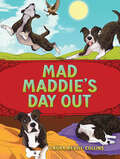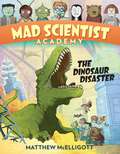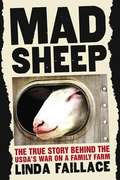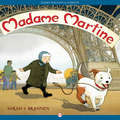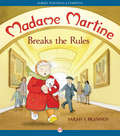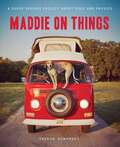- Table View
- List View
Mabel Jones and the Doomsday Book
by Will MabbittDelivering belly laughs and heart-stopping action in equal measure, this third installment of the Mabel Jones saga is an excellent family read-aloud.Trapped in the Noo World, Mabel Jones is determined to make the most of her time in this strange future run by animals. Her next mission: find the Doomsday Book, a guidebook used to wipe out humanity. If Mabel learns what happened to her species, there's a chance she can prevent its extinction. But an elusive creature known as Von Klaar is also after the book . . . can Mabel find it before it lands in the wrong hands? Join Mabel and her crewmates as they race Von Klaar to the sacred city of Otom. Hoomankind depends on it!From the Hardcover edition.
Mabel Jones and the Forbidden City
by Ross Collins Will MabbittA funny fantasy-adventure series for fans of LEMONY SNICKET, NEIL GAIMAN, and CRESSIDA COWELLWhat do you do when you survive a pirate kidnapping, a milk-drinking contest with a giant grizzly bear, and a stint inside the belly of a whale? If you're Mabel Jones, you do everything you can to avoid another UNLIKELY ADVENTURE! But when Mabel's baby sister is plucked from her crib by an EVIL witch, Mabel has no choice but to follow both to the jungles of the Forbidden City. Joining a brand-new cast of characters--and a few familiar faces from The Unlikely Adventures of Mabel Jones--Mabel races an arrogant fox, slays a ferocious millipede, and battles the diabolical witch. But is she prepared to make the ULTIMATE SACRIFICE to save her sister?From the Hardcover edition.
Mac and Cheese and the Perfect Plan (I Can Read Level 1)
by Sarah WeeksA funny friendship story from New York Times bestselling author Sarah WeeksMac wants to spend a day at the beach, but Cheese would rather stay in bed.Can Mac convince his best friend that the sea is the place to be?Mac and Cheese and the Perfect Plan is a Level One I Can Read book, which means it’s perfect for children learning to sound out words and sentences. Whether shared at home or in a classroom, the short sentences, familiar words, and simple concepts of Level One books support success for children eager to start reading on their own.Don’t miss these other children’s books by Sarah Weeks:Baa-Choo!Drip, DropLizzy McTizzy and the Busy Dizzy DayMac and CheeseMac and Cheese and the Perfect PlanOh My Gosh, Mrs. McNoshPip SqueakSplish, Splash!Woof: A Love StoryWithout You
Mac on a Hot Tin Roof
by Melinda MetzInspired by the true story of a kleptomaniac cat who stole his way into America&’s heart . . . KITTENS CABOODLE As a tabby cat with criminal tendencies, MacGyver is always a whisker away from trouble. But when he stumbles upon a litter of four motherless kittens, he really has his paws full. It&’s clear Mac has to take care of the cuddly little furballs, at least until he finds them each a human. That&’s not going to be easy though. Not when Mac&’s the prime suspect in a series of thefts at Storybook Court—and his loving but concerned owners, Jamie and David, have put him under house arrest. As if that could stop a clever cat like Mac . . . HUMANS CANOODLE With four hungry little mouths to feed—and two local detectives on his tail—MacGyver has his work clawed out for him. He&’s determined to sniff out the real thief. But when he gets a whiff of romance in the air, he can&’t resist a little matchmaking, too. One of the detectives seems awfully fond of the aspiring actress who moved into the neighborhood. And his partner looks like she could use a hug, too. With a little help from those adorable kittens, Mac is sure that love will save the day. Because when it comes to stealing hearts, this cat&’s out of the bag . . . RAVES FOR TALK TO THE PAW &“Filled with romance and adorable kitty antics . . . a light and cozy read!&”—Modern Cat &“Surpassingly cute story of a matchmaking cat determined to pair off his human with a neighbor through the power of stinky laundry.&”—Kirkus Reviews
MacGoose's Grocery
by Frank AschThe MacGoose family own a grocery store. Every day they sit in it waiting for customers. Then one day while they're out for a walk, some playful weasels come to their store. ile they are out for a walk, some
Macaws (Animals)
by Jaclyn JaycoxMacaws are among the most colorful members of the parrot family. These smart birds live in the rain forest. They use their bony tongues to crack into nuts and seeds. Find out more about these fancy fliers!
Macca la alpaca (Macca the Alpaca)
by Matt CosgroveMacca the alpaca's days were happy and carefree until -- drama! -- a llama.En este estrafalario y adorable libro ilustrado, Maca la Alpaca adora saltar en los charcos y es la mejor dando abrazos, pero cuando aparece una llama grande y abusona, llamada Harmer, Maca debe probar su astucia y su amabilidad.In this adorable, quirky picture book, Macca the alpaca loves splashing in puddles and gives the best cuddles. But when he bumps into a big bullying llama named Harmer (who's no charmer), Macca must prove the value of smarts and kindness.
Macca the Alpaca (Macca The Alpaca Ser. #1)
by Matt CosgroveMacca the alpaca's days were happy and carefree until -- drama! -- a llama.In this adorable, quirky picture book, Macca the alpaca loves splashing in puddles and gives the best cuddles. But when he bumps into a big bullying llama named Harmer (who's no charmer), Macca must prove the value of smarts and kindness.
Machine Learning in Aquaculture: Hunger Classification of Lates calcarifer (SpringerBriefs in Applied Sciences and Technology)
by Zahari Taha Anwar P. P. Abdul Majeed Gian-Antonio Susto Yukinori Mukai Mohd Azraai Mohd Razman Rabiu Muazu MusaThis book highlights the fundamental association between aquaculture and engineering in classifying fish hunger behaviour by means of machine learning techniques. Understanding the underlying factors that affect fish growth is essential, since they have implications for higher productivity in fish farms. Computer vision and machine learning techniques make it possible to quantify the subjective perception of hunger behaviour and so allow food to be provided as necessary. The book analyses the conceptual framework of motion tracking, feeding schedule and prediction classifiers in order to classify the hunger state, and proposes a system comprising an automated feeder system, image-processing module, as well as machine learning classifiers. Furthermore, the system substitutes conventional, complex modelling techniques with a robust, artificial intelligence approach. The findings presented are of interest to researchers, fish farmers, and aquaculture technologist wanting to gain insights into the productivity of fish and fish behaviour.
Machine Learning in Farm Animal Behavior using Python
by Natasa Kleanthous Abir HussainThis book is a comprehensive guide to applying machine learning to animal behavior analysis, focusing on activity recognition in farm animals. It begins by introducing key concepts of animal behavior and ethology, followed by an exploration of machine learning techniques, including supervised, unsupervised, semi-supervised, and reinforcement learning. The practical section covers essential steps like data collection, preprocessing, exploratory data analysis, feature extraction, model training, and evaluation, using Python.The book emphasizes the importance of high-quality data and discusses various sensors and annotation methods for effective data collection. It addresses key machine learning challenges such as generalization and data issues. Advanced topics include feature selection, model selection, hyperparameter tuning, and deep learning algorithms. Practical examples and Python implementations are provided throughout, offering hands-on experience for researchers, students, and professionals aiming to apply machine learning to animal behavior analysis.
Machine Learning in Medicine
by Aeilko H. Zwinderman Ton J. CleophasMachine learning is a novel discipline concerned with the analysis of large and multiple variables data. It involves computationally intensive methods, like factor analysis, cluster analysis, and discriminant analysis. It is currently mainly the domain of computer scientists, and is already commonly used in social sciences, marketing research, operational research and applied sciences. It is virtually unused in clinical research. This is probably due to the traditional belief of clinicians in clinical trials where multiple variables are equally balanced by the randomization process and are not further taken into account. In contrast, modern computer data files often involve hundreds of variables like genes and other laboratory values, and computationally intensive methods are required. This book was written as a hand-hold presentation accessible to clinicians, and as a must-read publication for those new to the methods.
Mack's Road Trip (Read and Roll)
by Amy ParadisIt may be bright and early, but Mack is revved up to hit the road for a relaxing vacation. Get set to come along on Mack's Road Trip!
Macro Photography for Gardeners and Nature Lovers: The Essential Guide to Digital Techniques
by Alan L. DetrickGardeners and nature lovers delight in taking pictures—especially close-ups of flowers, butterflies, and insects. And though advances in digital camera technology have made taking, storing, and sharing photos easier than ever, taking top-quality pictures requires familiarity with both digital technology and the general principles of photography. Macro Photography for Gardeners and Nature Lovers provides exactly the information that aspiring photographers—no matter their level of skill—need to take their photos to the next level. Clear and concise chapters cover the basics of macro (close-up) photography, explain the features of current digital single-lens reflex cameras, show the many ways images can be composed, and share tips on digital effects, storage, and manipulation of imagery. Throughout the text, helpful tips, definitions, exercises, and case studies serve to demystify digital photography. Each lesson is supported by examples of the author's stunning photography. Whether taking photos of flowers and insects, compiling a photographic record of your garden, or simply sharing beautiful images with friends and family, everyone can become accomplished photographers of the world's small-scale wonders.
Macroevolution in Deep Time
by Alexander J. Bartholomew Rituparna BoseThe prerequisite to investigating the underlying causes behind mass extinction is a profound understanding of the evolutionary history of both living and dead species. It is especially important to appreciate the significance of such studies in extinct organisms; especially in organisms that were abundant in a certain geologic era, but have subsequently dwindled or become extinct. Such studies should help to accurately evaluate patterns of evolution in extinct species lineages and help predict the same in its modern analogs. The book includes cutting edge research in evolutionary biology that should serve as a starting point for conservation.
Mad About Dinosaurs!
by Giles AndreaeJoin all your favourite dinosaurs in this colourful, rhyming picture book, from the author of international bestseller, Giraffes Can't Dance!Silly Diplodocus, fierce T-Rex, Brontosaurus, Stegosaurus and more... They're all here in this bright, bold book! With a short lively rhyme on each page, fun facts and colourful pictures (plus handy pronunciation guides) this is perfect for young dinosaur fans everywhere."Larger than life dinosaurs, in full glorious technicolour... bound to become another sure-fire hit" Books for KeepsPreviously published under the title Dinosaurs Galore.
Mad About Meatloaf (Weenie Featuring Frank and Beans #1)
by Maureen FergusMeet Weenie, a food-obsessed wiener dog, and his best friends Frank and Beans in this hilarious early graphic novel for fans of Narwhal and Jelly and The Bad Guys.Weenie loves his human, Bob. He loves his guinea pig friend, Beans, and his cat friend, Frank. He loves naps, adventures and sharing. In fact, Weenie loves pretty much everything (except the mail carrier). But the thing Weenie loves and desires more than anything else in the world is meatloaf. And he'll do anything to get it. Join Weenie, Frank and Beans on a laugh-out-loud meatloaf adventure, complete with a trench coat disguise, a wild meatloaf trap and even a hungry wolf.
Mad About Monkeys
by Owen DaveyWith over 250 species inhabiting our planet, this book explores the many different types of monkeys from the smallest Pygmy Marmoset to the largest Mandrill, and provides all the facts you wanted to know and more. <P><P>Discover where monkeys come from, how they swing from tree to tree, and why they fight and play with each other. After reading this beautifully illustrated book, you'll soon be raving mad about monkeys!
Mad Dog (Starlight Animal Rescue #2)
by Dandi Daley MackallMeet 14-year-old Wes Williams, aka |Mad Dog". He's from Chicago and looking to return -- just as soon as his mother gets out of rehab. In the meantime, he's stuck at Starlight Animal Rescue, where his only friend is his dog, Rex. As Wes schemes to get his old life back, will Rex and the other shelter dogs be able to rescue him... before his anger makes him go too far? Starlight Animal Rescue: Where problem horses are trained and loved, where abandoned dogs become heroes, where stray cats become loyal companions. And where people with nowhere to fit in find a place to belong.
Mad Dog Mcgraw
by Myron Uhlberg Lydia MonksHe growls at trucks. He snaps at clouds. He barks at rain. Mad Dog McGraw is one mean dog. What's a kid to do? First he tries stilts, but his left stilt gets stuck in a crack; then he tries an umbrella, but the wind only carries him so far. He even tries a cat named Bait--but Bait LOVES Mad Dog! With some hard thinking and a little courage (and a dog biscuit, for good measure), our protagonist comes to a startling realization. Maybe Mad Dog's bark is worse than his bite. The perfect book for kids who worry about dogs, as well as the kids who already love them. Mad Dog McGraw may show his teeth to the wind, but deep down, he's just a pussycat. Picture descriptions added.
Mad Maddie's Day Out
by Laura Revill-Collins‘Maddie, Maddie, where are you?’ The Knotts family’s beloved Staffordshire bullterrier had vanished! Join Maddie, a mischievous yet affectionate pup, on a whirlwind adventure through her quaint village home. Her curious nature leads her into a series of misadventures and close calls as she sneaks out one morning to explore. Maddie’s escapades cause quite a commotion, narrowly avoiding a collision with Mr. Briggs, the village postman’s van. Luckily, the tantalizing aroma emanating from Mrs. Bobbins’ Bread Shop proves irresistible to Maddie, and she’s treated to a tasty snack. But as she attempts to find her way back home, Maddie realizes she’s lost! What will she do now? Follow Maddie’s journey as she tries to navigate her way back to the loving embrace of William and Violet. Will she find her way home safely after all the excitement, or will her curious nature lead her into more mischief along the way?
Mad Scientist Academy: The Dinosaur Disaster (Mad Scientist Academy #1)
by Matthew McElligottFans of Ada Twist, Scientist, will want to enroll in Dr. Cosmic's class of clever monsters at the Mad Scientist Academy as they solve the greatest challenges in science in this perfect blend of adventure and exploration. Welcome to Mad Scientist Academy! The first day of school is always exciting, and Dr. Cosmic&’s new students can&’t wait to get started. After their teacher reveals that their school pet, Oscar, is a dinosaur, they quickly realize Dr. Cosmic has an unusual teaching style. To find Oscar, the class has to follow the clues through the realistic dinosaur exhibit Dr. Cosmic designed and built over the summer. But when a malfunction causes the robotic dinosaurs to come alive, this prehistoric exhibit feels a little too real! &“Dr. Cosmic is plainly a colleague of Ms. Frizzle, and the mix of pithy banter, tumultuous field-trip mishaps, and science fact is as familiar as it is winning. Fans of the Frizz will be dino-delighted. Mad fun.&” —Kirkus Reviews, Starred &“Like Joanna Cole and Bruce Degen&’s &‘Magic School Bus&’ series (Scholastic), the use of a school setting, a quirky teacher, and wild hands-on learning situations provides an engaging blend of humor, adventure, and information.&” —School Library Journal &“One of Summer&’s Must-Read Children&’s Books.&” —Bookish.com Kids&’ Indie Next List
Mad Sheep
by Linda FaillaceIn the mid-1990s Linda and Larry Faillace had a dream: they wanted to breed sheep and make cheese on their Vermont farm. They did the research, worked hard, followed the rules, and, after years of preparation and patience, built a successful, entrepreneurial business. But just like that, their dream turned into a nightmare. The U. S. Department of Agriculture told them that the sheep they imported from Europe (with the USDA's seal of approval) carried a disease similar to the dreaded BSE or "mad cow disease. " After months of surveillance-which included USDA agents spying from nearby mountaintops and comically hiding behind bushes-armed federal agents seized their flock. The animals were destroyed, the Faillace's lives turned upside down, all so that the USDA could show the U. S. meat industries that they were protecting America from mad cow disease-and by extension, easing fears among an increasingly wary population of meat-eaters. "Mad Sheep" is the account of one family's struggle against a bullying and corrupt government agency that long ago abandoned the family farmer to serve the needs of corporate agriculture and the industrialization of our food supply. Similar to the national best-selling book, "A Civil Action," readers will cheer on this courageous family in its fight for justice in the face of politics as usual and the implacable bureaucracy of the farm industry in Washington, DC.
Madame Martine
by Sarah S. BrannenMadame Martine lives in Paris and follows the same routine every day. She takes for granted the beautiful things that exist all around her. She refuses to go to the Eiffel Tower because it's "just for tourists." One day Madame Martine finds a stray dog and decides to take him home. When she tries keeping her dog on the same schedule, he breaks free, leading Madame Martine on a wild chase up the Eiffel Tower! Upon reaching the top, she discovers how much beauty she has been missing all these years. From then on, the two friends try something different every week.
Madame Martine Breaks The Rules
by Sarah S. BrannenMadame Martine's friend Louis works at the Louvre Museum. When he suggests Madame Martine and her dog, Max, come visit him and see the works of art, Madame declines his invitation--she knows dogs are not allowed at the museum. But Max has a different plan! He sneaks into the Louvre and sends Madame and Louis on a chase around some of the world's most beautiful works of art.
Maddie on Things: A Super Serious Project About Dogs and Physics
by Theron HumphreyA rescue hound demonstrates her knack for balance across America in this heartwarming photography collection.Maddie is a sweet-tempered coonhound who accompanied her owner, Theron, on a yearlong, cross-country trip while he worked on a photojournalism project. In his spare time, Theron took photos of Maddie doing what she does best: standing on things. From bicycles to giant watermelons to horses to people, there really isn’t anything that Maddie won’t stand on with grace and patience. The poignant Instagram photos of this beautiful dog and her offbeat poses have captured the imagination of all those who long for a road trip with a good dog for company. Maddie on Things celebrates the strange talent of one special dog and will resonate with any dog lover who appreciates the quirky hearts (and extraordinary balance) of canines.
